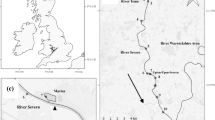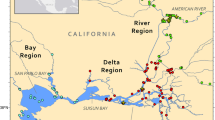Abstract
Radio-telemetry was used to study the late autumn and winter movements of twenty adult signal crayfish Pacifastacus leniusculus (32.9–63.8 mm carapace length) an introduced exotic crayfish species, in the upland River Wharfe, northern England. The distances moved during the study varied greatly between individuals (0–328 m). Movements were generally sporadic; crayfish would remain in one position for several weeks and make occasional movements to new locations. Total distances travelled, linear range and ranging area did not differ significantly between males and females. The distance travelled in upstream and downstream directions did not differ significantly and there was no correlation between distance travelled and crayfish size. Several high flow events occurred during the study, but these did not cause any mortality or apparent displacement of crayfish downstream, suggesting that this is not a significant factor in downstream dispersal or mortality of adults of this invasive crayfish species in winter. A marked reduction in large-scale movements occurred in mid-December which coincided with a decline in water temperature. There was a less distinct pattern in local activity which was strongly correlated with water temperature and varied before and after mid-December.
Similar content being viewed by others
References
Abrahamsson, S., 1981. Trappability, locomotion, and diel pattern of activity of the crayfish Astacus astacus and Pacifastacus leniusculus Dana. Freshwat. Crayfish 5: 239-253.
Alderman, D. J., D. M. Holdich & I. D. Reeve, 1990. Signal crayfish a vector in crayfish plague in Britain. Aquaculture 86: 3-6.
Black, J. B., 1963. Observations on the home range of streamdwelling crawfishes. Ecology 44: 592-595.
Bohl, E., 1999. Motion of individual noble crayfish Astacus astacus in different biological situations: in-situ studies using radio telemetry. Freshwat. Crayfish 12: 677-687.
Brewis, J. M. & K. Bowler, 1982. The growth of the freshwater crayfish Austropotamobius pallipes in Northumbria. Freshwat. Biol. 12: 187-200.
Gherardi, F. & S. Barbaresi, 2000. Invasive crayfish: activity patterns of Procambarus clarkii in the rice fields of the Lower Guadalquivir. Arch. Hydrobiol. 150: 153-168.
Gherardi, F., S. Barbaresi & F. Villanelli, 1998. Movement patterns of the white-clawed crayfish Austropotamobius pallipes, in a Tuscan Stream. J. Freshwat. Ecol. 134: 413-424.
Guan, R.-Z. & P. Wiles, 1997. The home range of signal crayfish in a British lowland river. Freshwat. Forum 8: 45-54.
Guan, R.-Z. & P. Wiles, 1998. Feeding ecology of the signal crayfish Pacifastacus leniusculus in a British lowland river. Aquaculture 169: 177-193.
Holdich, D. M., 1999. The negative effects of established crayfish introductions. In Gherardi, F. & D. M. Holdich (eds), Crayfish in Europe as Alien Species: How to Make the Best of a Bad Situation? A.A. Balkema, Rotterdam: 31-49.
Holdich, D. M. & J. C. J. Domaniewski, 1995. Studies on a mixed population of the crayfish Austropotamobius pallipes and Pacifastacus leniusculus in England. Freshwat. Crayfish 10: 37-45.
Kirjavainen, J. & K. Westman, 1999. Natural history and development of the introduced signal crayfish, Pacifastacus leniusculus, in a small, isolated Finnish lake, from 1968 to 1993. aquat. Living Resour. 12: 387-401.
Lancaster, J., A. G. Hildrew & C. Gjerlov, 1996. Invertebrate drift and longitudinal transport processes in streams. Can. J. Fish. aquat. Sci. 53: 572-582.
Lowery, R. S. & D. M. Holdich, 1988. Pacifastacus leniusculus in North America and Europe with details of the distribution of introduced and native crayfish species in Europe. In Holdich, D. M. & R. S. Lowery (eds), Freshwater Crayfish: Biology, Management and Exploitation. Chapman & Hall, London: 283-308.
Lozán, J. L., 2000. On the threat to the european crayfish: a contribution with the study of the activity behaviour of four crayfish species (Decopoda: Astacidae). Limnologica 30: 156-161.
Lucas, M. C. & E. Batley, 1996. Seasonal movements and behaviour of adult barbel Barbus barbus, a riverine cyprinid fish: implications for river management. J. appl. Ecol. 33: 1345-1358.
Lucas, M. C., T. Mercer, E. Batley, P. A. Frear, G. Peirson, A. Duncan & J. Kubecka, 1998. Spatio-temporal variations in the distribution and abundance of fish in the Yorkshire Ouse system. Sci. Total Environ. 210/211: 437-455.
Matthews, M. A. & J. D. Reynolds, 1995. A population study of the white-clawed crayfish Austropotamobius pallipes (Lereboullet) in an Irish reservoir. Biol. Environ. 95B: 99-109.
McCreesh, P. A., 2000. Effects of a fisheries restoration scheme on the biological communities of the Rye Water, an Irish lowland river. Ph.D. Thesis, University College Dublin, Ireland.
Momot, M. T., 1966. Upstream movement of crayfish in an intermittent Oklahoma stream. Am. Midl. Nat. 75: 150-159.
Parkyn, S. M., 2000. Effects of native forest and pastoral land use on the population dynamics and trophic role of the New Zealand freshwater crayfish Paranephrops planifrons (Parastacidea). Ph.D. Thesis, University of Waikato, New Zealand.
Peay, S. & D. Rogers, 1999. The peristaltic spread of signal crayfish (Pacifastacus leniusculus) in the River Wharfe, Yorkshire, England. Freshwat. Crayfish 12: 665-676.
Riggert, C. M., R. J. Distefano & D. B. Noltie, 1999. Distributions and selected aspects of the life histories and habitat associations of the crayfishes Orconectes peruncus (Creaser, 1931) and O. quadruncus (Creaser, 1933) in Missouri. Am. Midl. Nat. 142: 348-362.
Robinson, C. A., T. J. Thom & M. C. Lucas, 2000. Ranging behaviour of a large freshwater invertebrate, the white-clawed crayfish Austropotamobius pallipes. Freshwat. Biol. 44: 509-521.
Schütze, S., H. Stein & O. Born, 1999. Radio telemetry observations on migration and activity patterns of restocked noble crayfish Astacus astacus (L.) in the small river Sempt, North-East of Munich, Germany. Freshwat. Crayfish 12: 688-695.
Söderbäck, B., 1995. Replacement of the native crayfish Astacus astacus by the introduced species Pacifastacus leniusculus in a Swedish lake: possible causes and mechanisms. Freshwat. Biol. 33: 291-304.
Sutherland, W. J., 1996. From Individual Behaviour to Population Ecology. Oxford University Press, Oxford.
Thomas, W. & R. Ingle, 1971. The nomenclature, bionomics and distribution of the crayfish Austropotamobius pallipes (Lereboullet) (Crustacea, Astacidae) in the British Isles. Essex Nat. 32: 349-360.
Author information
Authors and Affiliations
Rights and permissions
About this article
Cite this article
Bubb, D.H., Lucas, M.C. & Thom, T.J. Winter movements and activity of signal crayfish Pacifastacus leniusculus in an upland river, determined by radio telemetry. Hydrobiologia 483, 111–119 (2002). https://doi.org/10.1023/A:1021363109155
Issue Date:
DOI: https://doi.org/10.1023/A:1021363109155




